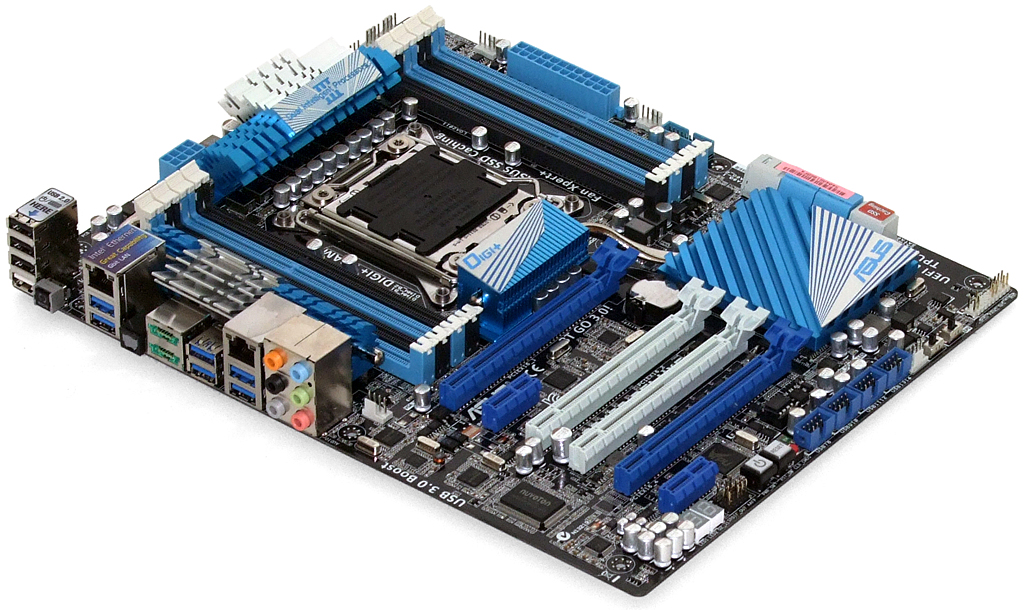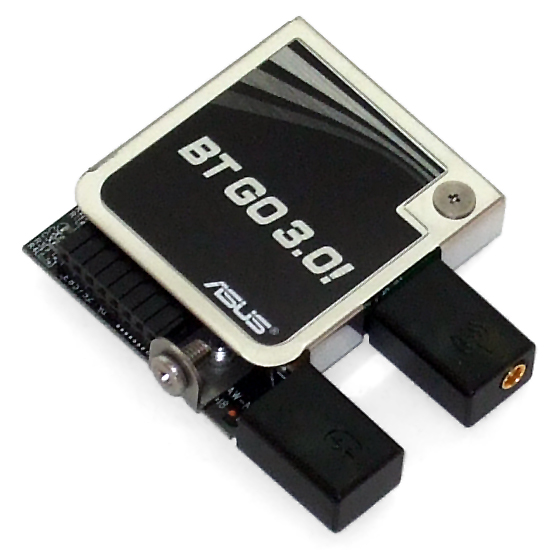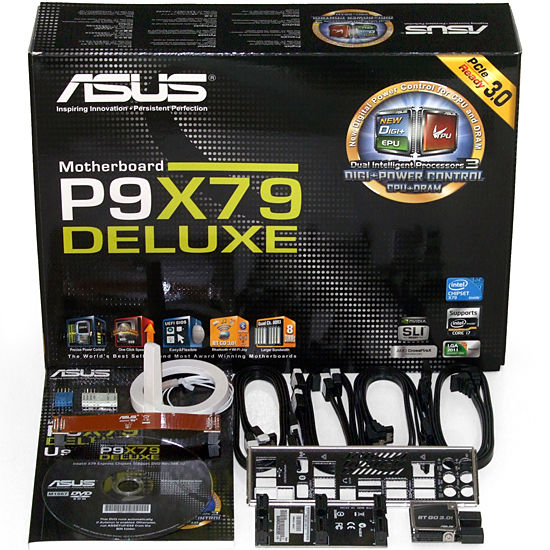Ultimate X79? Five $320+ LGA 2011 Motherboards, Reviewed
Our flagship motherboard comparison announcement was answered with an interesting selection of models, along with a bunch of “not ready yet” responses. Today we examine a few samples from companies bold enough to step up to the plate during launch week.
Asus P9X79 Deluxe
Asus caters to the high-end market’s connectivity needs with six USB 3.0 ports on the P9X79 Deluxe’s rear panel, in addition to two front-panel ports, four internal USB 2.0 headers, and four rear-panel ports. If that's not enough, one of the always-deluxe dual gigabit Ethernet network connectors is fed by Intel’s reputable PHY.
Asus’ BT Go 3.0 module adds both Bluetooth and Wi-Fi to the I/O panel, plugging between Asus’ USB BIOS Flashback switch and the first set of USB 3.0 ports. USB BIOS Flashback allows BIOS to be updated from a USB flash drive (in the white USB 2.0 port) with nothing more than power cords connected.
The blue PCIe x16 slots each feature a full set of pathways connected directly to the CPU, spaced four slots apart for perfect graphics cooling, even with triple-slot cards. We did find a problem in the manual, however, which lists the wrong slot order. The two x16 slots in the middle are visibly wired for eight lanes, and the second of those two borrows its lanes from the bottom slot whenever a card is installed there.
That means three-way CrossFireX and SLI are possible within a standard seven-slot case, given x16-x8-x16 transfers, with each card spaced two slots apart. Quad-card arrays could be possible with single-slot cards, but the only single-slot boards you'll find with two bridges are high-end liquid-cooled parts.
The P9X79 Deluxe’s remaining layout is fairly good, with the front-panel audio cable moved forward along the motherboard’s bottom edge for easier cable reach, and the front-panel USB 3.0 header placed above all expansion slots on the front edge. The eight-pin ATX/EPS 12V header’s latch is on the top, which could cause a little difficulty removing the cable if the builder wraps it around the back of a motherboard tray.
We should also mention that four of the P9X79 Deluxe’s rear USB 3.0 ports are shared on a VL810 hub, a fact that might be noticed by anyone who tries to ram 20 Gb/s of data through its constrained 5 Gb/s connection.
We really love that Asus includes eight internal SATA cables with the eight-port P9X79 Deluxe, along with a Wi-Fi antenna, a flexible SLI bridge, and a rigid three-way SLI bridge. CrossFire users should find the appropriate bridges packaged with their cards.
Get Tom's Hardware's best news and in-depth reviews, straight to your inbox.
-
lradunovic77 Something is wrong with your ASRock Extreme 9 testing. You article states that you used BIOS 1.40 however first release for this Motherboard was 1.60 and they also recently released 1.70. Bios 1.40 is for ASRock Extreme 4 which i own as well. Again in mean time they updated BIOS for ASRock Extreme 4 to version 1.50 which greatly improves overclocking. I have C1 and i am hitting 4.4Ghz easily. (1.50 BIOS ASRock Extreme 4).Reply
You might want re check the facts.
Thanks. -
Crashman lradunovic77Something is wrong ...You might want re check the facts.Please do verify the facts beginning with the first X79 Extreme9 UEFI screenshot on page 3, showing version P 1.40 . The latest public firmware was downloaded for every motherboard on November 18, which is before ASRock says its P1.60 was even published. And, if you check Newegg, you'll find that Newegg was actually selling the X79 Extreme9 before firmware P1.60 was published.Reply
How could that happen? ASRock has repeatedly removed previous BIOS versions from its website and labeled the replacement as the initial release.
This review was published after many hours of collaboration with ASRock, and some of the problems with this specific CPU are further detailed in the overclocking section. ASRock acknowledged the problem exists with a portion of the C1 CPU supply and has begun issuing patched BIOS to fix the multiplier issue, according to ASRock engineer William Yu. -
oxxfatelostxxo ReplyI have C1 and i am hitting 4.4Ghz easily. (1.50 BIOS ASRock Extreme 4).
Not to mention that they didnt say they couldnt hit 4.4ghz, they just stated they didnt get that high without going beyond 1.35v
Kinda wish we got to see a MAX overclock for air before temps got out of control =P
But then you get various coolers involved... yada yada... but PLEASE anyway -
clonazepam This was a fun article to read. I wanted to quote a few bits here and there just to point out I enjoyed the humor in it, but that would have been a lot of quotes. It's subtle, tasteful way to add personality to the piece.Reply
I had to comment on something. I can't really comment on the hardware as its so enthusiast and SB-E is well beyond my needs. I can't comment too much on the bios because I still barely understand mine, but I am seeing the trend that it might be best to stick with what you know, or risk having to translate the various names/definitions of settings across different products. I'm not that smart nor that patient. I liked the comment on the 6.00...lol... %! I never would have thought. I think that just deciphered half of my bios options, thanks. /wink -
In the comparison table on the ASUS : "6 (x16/x0/x4/x16/x4/x0 or x8/x8/x4/x8/x84/x8)" -- x84 seems somewhat unlikely ;-)Reply
-
gmcizzle Not surprised both Asus boards came out on top performance wise, on most of these mobo roundups they usually do.Reply -
Steveymoo Without trying to sound critical, wouldn't it be prudent to test SLI scaling on these enthusiast boards? 1, 2, and 3 way SLI, extra PCI-E bandwidth is one of the main reason why people even bother splashing out the extra cash on these chipsets. (Aside from the extra epeen++)Reply
Just sayin' -
Crashman shstoneIn the comparison table on the ASUS : "6 (x16/x0/x4/x16/x4/x0 or x8/x8/x4/x8/x84/x8)" -- x84 seems somewhat unlikely ;-)Thanks. Yes, the x4 stays the same. Fixed!SteveymooWithout trying to sound critical, wouldn't it be prudent to test SLI scaling on these enthusiast boards? 1, 2, and 3 way SLI, extra PCI-E bandwidth is one of the main reason why people even bother splashing out the extra cash on these chipsets. (Aside from the extra epeen++)Just sayin'You obviously don't understand the value of those +++'s!Reply -
AstroTC AsRock has the better looking MB by far...Reply
Question does tht little fan on the motherboard get loud? If it does that would be a deal breaker for me -
CaedenV the problem with testing mobos is that they all have the same core (in this case the x79) which is what determines the raw speed of the system and busses, so they are all pretty well bunched together with no possibility of seeing any real world difference between boards. The things that differentiate the boards is in their feature sets, and as they are all rather different there is no proper way to test them against one another. Add to that the fact that these are all brand new boards which will see improvements with new UEFI releases, and there is really no way to pick a clear winner.Reply
On a side note I would love to see how these boards look assembled :)




